瑞士万通 870 KF Titrino plus共92页文档
瑞士万通水分仪培训资料
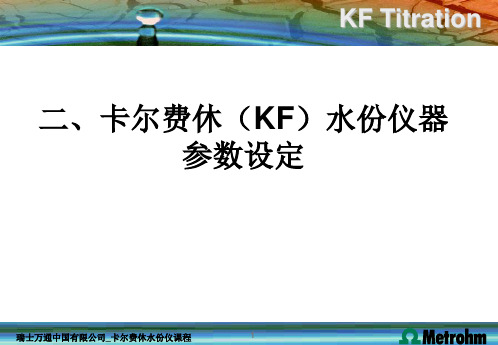
13
KF Titration
平衡时间与漂移值的关系
l 两个稳定条件只能选择一个. l 二者之间是对应关系:
瑞士万通中国有限公司_卡尔费休水份仪课程
14
KF Titration
漂移停止判据 drift stop
Drift / µl/min
基线漂移 例如: 6 µl/min
加入样品
瑞士万通中国有限公司_卡尔费休水份仪课程
打印机,天平的接口设置
波特率 数据位 停止位 奇偶性
信号交换式 C30...C39,一般为空白和滴定度。
卡氏试剂的滴定度一般为C39。
瑞士万通中国有公司_卡尔费休水份仪课程
9
KF Titration
滴定参数-parameters <PARAM>键
瑞士万通中国有限公司_卡尔费休水份仪课程
10
KF Titration
瑞士万通中国有限公司_卡尔费休水份仪课程
8
KF Titration
仪器参数---configuration
l RS232设置RS232 settings
– baud rate: – data bit: – stop bit: – parity: – handshake:
l 公共变量com.var.
4
KF Titration
仪器参数---configuration <CONFIG>键
瑞士万通中国有限公司_卡尔费休水份仪课程
5
KF Titration
仪器参数---configuration
l 监控monitoring
– 检定validation:
监控检定周期
– 校正calibration:(只有758有此功能) 监控pH校正周期
KF简介卡尔费休(KF)水份滴定原理
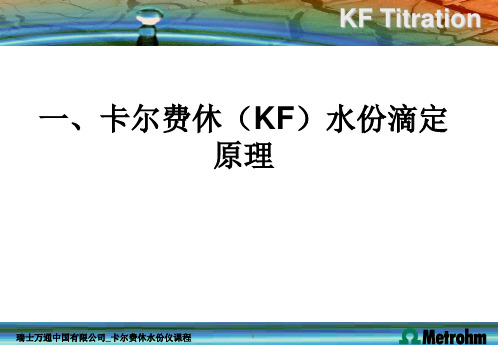
Statistics(统计) Recalculation(重新计算) Routine dialog
+ + +
+ + +
Internal printer(内置打印机)
GLP(GLP测试)
+
+
+
瑞士万通中国有限公司_卡尔费休水份仪课程
34
KF Titration
756 KF- Coulometer
瑞士万通中国有限公司_卡尔费休水份仪课程
(RN =碱)
瑞士万通中国有限公司_卡尔费休水份仪课程
2
KF Titration
KF试剂的基本组成
l
l
l
l
碘 二氧化硫 碱 溶剂
I2 SO2 咪唑 甲醇
瑞士万通中国有限公司_卡尔费休水份仪课程
3
KF Titration
KF滴定的优点
方法简单,容易操作
是专一性的测定水份的方法 测量结果准确度高,重现性好。 测量范围宽: 10g - 100% 分析时间短: 2 -5 minutes
835836titrando799gpttitrino容量法卡氏水份仪使用万通metrohm的活塞式滴定管和插入式交换单元才使容量法卡氏水份测定变为非常简单高分辨率的滴定仪titrino110000精度titrando120000精度保证了滴定的准确787kftitrino操作方便的交换单元703滴定台titrando系列titrando系列835kfdtitrando836kfdtitrando803滴定台库仑法kf水份仪可以使用有隔膜和无隔膜发生电极可以内存各种分析方法应付复杂的试验预知kf试剂的寿命可以实现自动更换试剂库仑法kf水份仪库仑法kf水份仪756kfcoulometer831kfcoulometer卡氏炉768kfoven传统型的干燥炉带样品舟832thermoprep新型干燥炉样品置于小的安培瓶中832thermoprep768和832的异同全自动kf滴定774自动进样炉全自动kf滴定824易操作自动进样器kf滴定的滴定头全自动kf滴定814usb接口自动进样器内置磁力搅拌msb接口抽排液泵前置更易于操作可选试剂瓶组织单元废液瓶防溢出保护100100usermethods用户方法automation自动化software软件livedisplay实时显示756kfcoulometer831kfcoulometerinternalprinter内置打印机glpglp测试routinedialogrecalculation重新计算statistics统计756kfcoulometer831kfcoulometer滴定池样品瓶放入卡氏炉中卡氏炉的测定原理768kfoven容量法和库仑法均可容量法和库仑法均可水份测量方式可在样品的上方也可通过样品在样品的上方载气流可变固定盛装样品的容器规格50
瑞士万通831 KF 水份分析仪中文版操作手册

广州代表处
广州先烈中路 80 号 汇华商贸大厦 21 楼 K 单元
邮编: 510070 电话: 020-37617902
37617903 37617939 传真: 020-37616051
成都技术支援中心
成都市一环路南一段 20 号 普利大厦 410 房 邮编: 610021 电话: 028-5239418
执行干燥时,灯闪烁,滴定池仍未干燥。达到干燥时,灯亮。
“STATISTICS” 启动“STATISTICS”功能时(计算平均值和标准偏差),灯亮。
“SILO”
启动仓储记忆时(样品数据),灯亮。
4
显示对比度设置
仪器面板
6
KF Coulometer
仪器后板
KFC 库仑法水分测定仪
仪器后板:
5
RS 232 接口
5 准备………………………………………………………………………………………………… 62
5.1 安装仪器………………………………………………………………………………………… 62
5.1.1 连接搅拌器或滴定台………………………………………………………………………. 62
5.1.2 安装内置热敏打印机的打印纸……………………………………………………………. 63
12
连接电源电缆
由于电源电压易强高频干扰,Coulometer 内设有附加电源滤波器,
例如:Metrohm 615 型。
13
散热片
14
标定牌
生产、系列和仪器编号。
KF Coulometer
7
KFC 库仑法水分测定仪
2. 湿化学部分
⎯⎯⎯⎯⎯⎯⎯⎯⎯⎯⎯⎯⎯⎯⎯⎯⎯⎯⎯⎯⎯⎯⎯⎯⎯⎯⎯⎯⎯⎯⎯⎯⎯⎯⎯⎯⎯⎯⎯⎯⎯⎯⎯
KF仪器参数设置
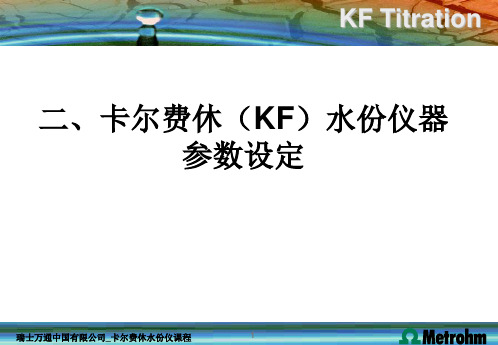
瑞士万通中国有限公司_卡尔费休水份仪课程
7
KF Titration
仪器参数---configuration
辅助功能auxiliaries
– – – – – – – – – 语种dialogue: 日期date: 时间time: 编号run number: 自动开始auto start: 开始延迟start delay: 结果显示result display: 设备标记device label: 程序版本program 选择对话语言English, Franch, Germany 现时日期 现时时间 开机后样品测定的次数0,1,... 9999 自动开始滴定 启动方法后的延迟时间。 bold(黑体)standard(标准字体) 滴定仪的编号或代码 滴定仪内运行的程序版本如:795.0010
瑞士万通中国有限公司_卡尔费休水份仪课程
6
KF Titration
仪器参数---configuration
l 外设peripheral units
– 打印机send to: – 手动打印报告man. Reports to COM: – 天平banlance: – 记录仪record: – 搅拌控制stirrer control: – 连接远程接口remote box: 可以选择Epson,Seiko,Citizen,IBM 如果仪器后板有两个COM口,在此 选择手动打印报告的输出口。 可以选择Sartorius, Mettler, U, dU/dt, V, dV/dt, U(rel) 在滴定过程中自动开关搅拌 连接PC键盘或条形码读出器
瑞士万通中国有限公司_卡尔费休水份仪课程
13
KF Titration
平衡时间与漂移值的关系
瑞士万通离子色谱仪800 Dosino进样器说明书--英文
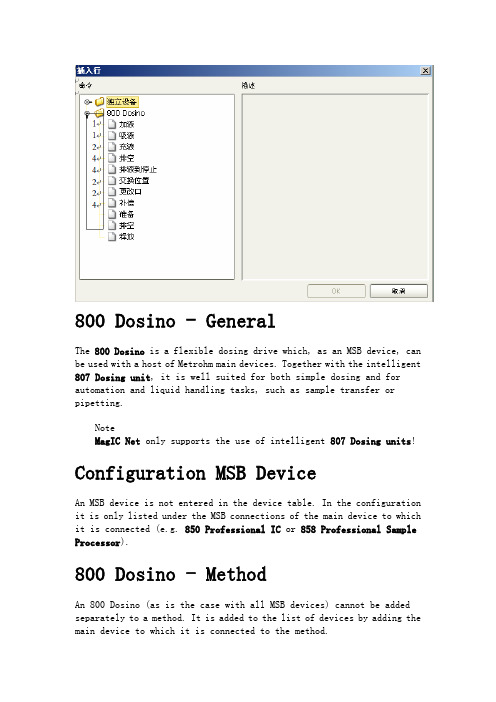
800 Dosino - GeneralThe 800 Dosino is a flexible dosing drive which, as an MSB device, can be used with a host of Metrohm main devices. Together with the intelligent 807 Dosing unit, it is well suited for both simple dosing and for automation and liquid handling tasks, such as sample transfer or pipetting.NoteMagIC Net only supports the use of intelligent 807 Dosing units! Configuration MSB DeviceAn MSB device is not entered in the device table. In the configuration it is only listed under the MSB connections of the main device to which it is connected (e.g. 850 Professional IC or 858 Professional Sample Processor).800 Dosino - MethodAn 800 Dosino (as is the case with all MSB devices) cannot be added separately to a method. It is added to the list of devices by adding the main device to which it is connected to the method.If the method is created without connected devices, the MSB device can be added separately. In this case, the MSB connector on the main device must be entered manually.In the device group, the 800 Dosino behaves like a stand-alone device. It can be selected and displayed graphically in the upper area of the device window.800 Dosino - Start parametersTab: Method ▶ Devices ▶ DosinoSolutionSelect the solution for the Dosino that should be available when the hardware is started with [Start HW]. A check is carried out in the method run to ensure that the correct solution has been put on the dosing device. When the method is started, the working life and GLP test interval are checked for the selected solution.Selection not defined | Solutions from the solution tableDefault value not definednot definedThe solution is not checked.Solutions from the solution tableOnly "intelligent" solutions, i.e. solutions that are assigned to an 807 Dosing unit, can be selected.ConnectorShows the main device and the MSB connector which the 800 Dosino is on.800 Dosino - CommandsOverview of the time program commands available for the 800 Dosino:DosingDialog window: Method ▶Time program ▶Edit ▶'Device' - DosingThe device-dependent time program command Dosing (command with feedback) doses the specified volume via the defined port. There is no automatic filling beforehand or afterwards.ParametersPortPort via which dosing takes place. Formula input possible.Range 1 (4)Default value 1V olumeVolume to be transported. Formula input possible.Range0.0000 ... 99999.9000 mLDefault value 1.0000 mLDosing rateSpeed at which discharge takes place. The maximum rate depends on the cylinder volume of the buret used. Formula input possible.Cylinder volume 2 mLRange0.01 ... 6.00 mL/minDefault value 1.00 mL/minSelection maximumCylinder volume 5 mLRange0.01 ... 16.00 mL/minDefault value 1.00 mL/minSelection maximumCylinder volume 10 mLRange0.01 ... 33.00 mL/minDefault value 1.00 mL/minSelection maximumCylinder volume 20 mLRange0.01 ... 66.00 mL/minDefault value 1.00 mL/minSelection maximumCylinder volume 50 mLRange0.01 ... 166.00 mL/minDefault value 1.00 mL/minSelection maximumFilling rateSpeed at which filling takes place. The maximum rate depends on the cylinder volume of the buret used. Formula input possible.Cylinder volume 2 mLRange0.01 ... 6.00 mL/minDefault value 1.00 mL/minSelection maximumCylinder volume 5 mLRange0.01 ... 16.00 mL/minDefault value 1.00 mL/minSelection maximumCylinder volume 10 mLRange0.01 ... 33.00 mL/minDefault value 1.00 mL/minSelection maximumCylinder volume 20 mLRange0.01 ... 66.00 mL/minDefault value 1.00 mL/minSelection maximumCylinder volume 50 mLRange0.01 ... 166.00 mL/minDefault value 1.00 mL/minSelection maximumCommentOptional comment on the time program command.Input64 charactersGenerated variablesThe following type 'mand number.Variable name' variables are generated by the command:AspirateDialog window: Method ▶Time program ▶Edit ▶'Device' - AspirateThe device-dependent time program command Aspirate (command with feedback) draws in the specified volume via the defined port. As with the command Dosing, the cylinder is not filled automatically beforehand or afterwards. It should be possible to achieve the volume to be aspirated with a single piston stroke.ParametersPortPort via which aspiration takes place. Formula input possible.Range 1 (4)Default value 1V olumeVolume to be transported. Formula input possible.Range0.0000 ... 50.0000 mLDefault value 1.0000 mLRateThe maximum rate depends on the cylinder volume of the buret used. Formula input possible.Cylinder volume 2 mLRange0.01 ... 6.00 mL/minSelection maximumDefault value maximumCylinder volume 5 mLRange0.01 ... 16.00 mL/minSelection maximumDefault value maximumCylinder volume 10 mLRange0.01 ... 33.00 mL/minSelection maximumDefault value maximumCylinder volume 20 mLRange0.01 ... 66.00 mL/minSelection maximumDefault value maximumCylinder volume 50 mLRange0.01 ... 166.00 mL/minSelection maximumDefault value maximumCommentOptional comment on the time program command.Input64 charactersGenerated variablesThe following type 'mand number.Variable name' variables are generated by the command:FillDialog window: Method ▶Time program ▶Edit ▶'Device' - FillThe device-dependent time program command Fill (command with feedback) fills the cylinder via the specified port. The valve disc stops on the selected port.ParametersPortPort via which filling takes place. Formula input possible.Range 1 (4)Default value 2RateThe maximum rate depends on the cylinder volume of the buret used. Formula input possible.Cylinder volume 2 mLRange0.01 ... 6.00 mL/minSelection maximumDefault value maximumCylinder volume 5 mLRange0.01 ... 16.00 mL/minSelection maximumDefault value maximumCylinder volume 10 mLRange0.01 ... 33.00 mL/minSelection maximumDefault value maximumCylinder volume 20 mLRange0.01 ... 66.00 mL/minSelection maximumDefault value maximumCylinder volume 50 mLRange0.01 ... 166.00 mL/minSelection maximumDefault value maximumCommentOptional comment on the time program command.Input64 charactersEject to end volumeDialog window: Method ▶Time program ▶Edit ▶'Device' - Eject to end volumeThe device-dependent time program command Eject to end volume (command with feedback) ejects the entire contents of the cylinder via the specified port. In contrast to the command Eject to stop, the piston travels to the maximum volume mark i.e. until it has performed 10,000 pulses. This command should be used for pipetting functions for emptying the cylinder.ParametersPortPort via which ejection takes place. Formula input possible.Range 1 (4)Default value 4RateThe maximum rate depends on the cylinder volume of the buret used. Formula input possible.Cylinder volume 2 mLRange0.01 ... 6.00 mL/minSelection maximumDefault value maximumCylinder volume 5 mLRange0.01 ... 16.00 mL/minSelection maximumDefault value maximumCylinder volume 10 mLRange0.01 ... 33.00 mL/minSelection maximumDefault value maximumCylinder volume 20 mLRange0.01 ... 66.00 mL/minSelection maximumDefault value maximumCylinder volume 50 mLRange0.01 ... 166.00 mL/minSelection maximumDefault value maximumCommentOptional comment on the time program command.Input64 charactersEject to stopDialog window: Method ▶Time program ▶Edit ▶'Device' - Eject to stopThe device-dependent time program command Eject to stop (command with feedback) ejects the entire contents of the cylinder via the specified port. The piston is lowered to the stop point, i.e. past the maximum volume mark.NoteThis function should only be carried out to eject any air bubbles present.CautionThe command aspirate does not function directly after Eject to stop.If aspiration is to take place after Eject to stop, then Eject to end volume must first be carried out. In this command, the port via which aspiration is to take place must already be selected.ParametersPortPort via which ejection takes place. Formula input possible.Range 1 (4)Default value 4RateThe maximum rate depends on the cylinder volume of the buret used. Formula input possible.Cylinder volume 2 mLRange0.01 ... 6.00 mL/minSelection maximumDefault value maximumCylinder volume 5 mLRange0.01 ... 16.00 mL/minSelection maximumDefault value maximumCylinder volume 10 mLRange0.01 ... 33.00 mL/minSelection maximumDefault value maximumCylinder volume 20 mLRange0.01 ... 66.00 mL/minSelection maximumDefault value maximumCylinder volume 50 mLRange0.01 ... 166.00 mL/minSelection maximumDefault value maximumCommentOptional comment on the time program command.Input64 charactersExchange positionDialog window: Method ▶Time program ▶Edit ▶'Device' - Exchange positionWith the device-dependent time program command Exchange position (command with feedback) the cylinder is first filled via the port specified. The valve disc is then turned to Port 2 and the dosing unit can be removed from the dosing drive.ParametersFill portPort via which filling takes place. Formula input possible.Range 1 (4)Default value 2RateThe maximum rate depends on the cylinder volume of the buret used. Formula input possible.Cylinder volume 2 mLRange0.01 ... 6.00 mL/minSelection maximumDefault value maximumCylinder volume 5 mLRange0.01 ... 16.00 mL/minSelection maximumDefault value maximumCylinder volume 10 mLRange0.01 ... 33.00 mL/minSelection maximumDefault value maximumCylinder volume 20 mLRange0.01 ... 66.00 mL/minSelection maximumDefault value maximumCylinder volume 50 mLRange0.01 ... 166.00 mL/minSelection maximumDefault value maximumCommentOptional comment on the time program command.Input64 charactersChange portDialog window: Method ▶Time program ▶Edit ▶'Device' - Change portThe device-dependent time program command Change port (command with feedback) results only in one rotation of the valve to the given port and not in any piston movement.ParametersPortPort to which the valve is rotated. Formula input possible.Range 1 (4)Default value 2CommentOptional comment on the time program command.Input64 charactersCompensateDialog window: Method ▶Time program ▶Edit ▶'Device' - CompensateBecause of the fact that the dosing units are interchangeable, the coupling of the Dosino piston rod (spindle) exhibits a low mechanical tolerance that can be noticed when the piston changes its direction of movement. This tolerance can be compensated for with the device-dependent time program command Compensate (command with feedback). A short piston movement is first made in the same direction as the previous movement, which is then followed by a piston movement in the reverse direction.ParametersPortPort via which the piston motion runs. Formula input possible.Range 1 (4)Default value 4CommentOptional comment on the time program command.Input64 charactersPrepareDialog window: Method ▶Time program ▶Edit ▶'Device' - PrepareThe device-dependent time program command Prepare (command with feedback) is used to prepare a dosing unit.The cylinder and all the tubing of a dosing unit are rinsed in an extensive cleaning sequence. The parameters required for this process are stored in the configuration of the solution.CommentOptional comment on the time program command.Input64 charactersEmptyDialog window: Method ▶Time program ▶Edit ▶'Device' - EmptyThe device-dependent time program command Empty (command with feedback) is used to empty the cylinder and the tubing of a dosing unit.The cylinder and all the tubing of a dosing unit are emptied in an extensive sequence. The parameters required for this process are stored in the configuration of the solution.CommentOptional comment on the time program command.Input64 charactersReleaseDialog window: Method ▶Time program ▶Edit ▶'Device' - 'Module' - ReleaseThe device-dependent time program command Release (command without feedback) releases the module/device for use by other methods running at the same time. It removes the reservation made by the current method.TimeTime at which the command is to be executed.Range0.00 ... 10000.00 minIncrement0.01 minDefault value0.00 minCommentOptional comment on the time program command.Input0 ... 64 characters800 Dosino - Manual ControlTab: Manual ▶Manual Control - 'Device name' ▶'Dosino'CommandSelection of the Dosino command that is to be triggered manually.Selection Dosing | Aspirate | Fill | Prepare | EmptyDefault value DosingDosingDoses the specified volume via the defined port. There is no automatic filling beforehand or afterwards.AspirateAspirates the specified volume via the defined port. There is no automatic filling beforehand or afterwards.FillThe cylinder is filled in a fixed sequence. The parameters required for this process are stored in the configuration of the solution.PrepareThe cylinder and all the tubing of a dosing unit are rinsed in an extensive cleaning sequence. The parameters required for this process are stored in the configuration of the solution.EmptyThe cylinder and all the tubing of a dosing unit are emptied in an extensive sequence. The parameters required for this process are stored in the configuration of the solution.SolutionDisplays the solution assigned to the Dosino.VolumeCurrent valueDisplays the current dosed volume.InputEnter the volume that is to be dosed / moved.Range0.0000 ... 99999.9000 (Exception: with command "Aspirate" 50.0000) mL Default value 1.0000 mLPortCurrent valueShows the current port.InputSelection of a port for the action selected in the parameter Command.Range 1 (4)Default value 1Dosing rateInputEnter dosing rate. The maximum rate depends on the cylinder volume of the buret used. Formula input possible.Cylinder volume 2 mLRange0.01 ... 6.00 mL/minSelection maximumDefault value maximumCylinder volume 5 mLRange0.01 ... 16.00 mL/minSelection maximumDefault value maximumCylinder volume 10 mLRange0.01 ... 33.00 mL/minSelection maximumDefault value maximumCylinder volume 20 mLRange0.01 ... 66.00 mL/minSelection maximumDefault value maximumCylinder volume 50 mLRange0.01 ... 166.00 mL/minSelection maximumDefault value maximumFilling rateInputEnter filling rate. The maximum rate depends on the cylinder volume of the buret used. Formula input possible.Cylinder volume 2 mLRange0.01 ... 6.00 mL/minSelection maximumDefault value maximumCylinder volume 5 mL Range0.01 ... 16.00 mL/minSelection maximumDefault value maximumCylinder volume 10 mL Range0.01 ... 33.00 mL/minSelection maximumDefault value maximumCylinder volume 20 mL Range0.01 ... 66.00 mL/minSelection maximumDefault value maximumCylinder volume 50 mL Range0.01 ... 166.00 mL/minSelection maximumDefault value maximum[Start]Start Dosino command.[Stop]Stop Dosino command.。
瑞士万通离子色谱仪操作培训PPT学习教案
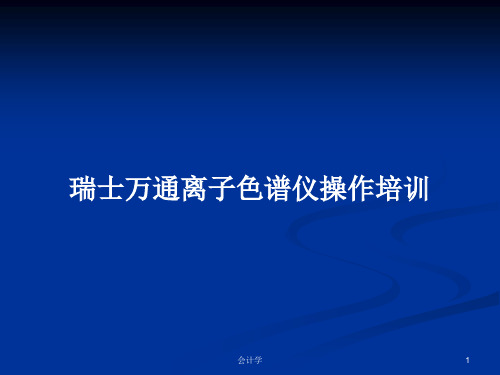
所有试剂都应当是分析纯以上,最好是优级纯。
标准品应当是离子色谱专用的。 例如:基体应该为水,而不是酸。
18
第17页/共26页
IC使用注意事项—CO2
由于CO2会影响Na2CO3-NaHCO3的平衡(使淋洗液变弱),淋洗液瓶应当总是加装CO2吸收管。 注意:
CO2吸收管里,装半管的CaO(碱石灰,钠石灰)即可,千万不要装得过满,否则可能会涨爆。 同样,弱缓冲能力的淋洗液必须避免CO2的吸收。
分离柱(500-1000ml/天)。 17 第16页/共26页
IC使用注意事项—水质
离子色谱以水性介质为主。因此水的好坏对结果至关重要。 水质不好则结果肯定不好,如:曲线线性不好,谱图中待测离子出现负
峰等。 水质不好还可能对仪器和分离柱有损坏。 IC 用水的要求:
电阻>18MΩ;无颗粒(<0.45m滤膜过滤)。
19
配置的基本要求:
化学组成明确而稳定
超纯水------〉达到18MΩ
有足够的纯度------〉优级纯
各化学成份比例准确------〉严格称量
无细小颗粒------〉0.45(或0.22)微米过滤(溶剂过滤器+真空
泵)
无气泡----〉超声/真空/惰性气体 –脱气(溶剂过滤器+真空泵)
❖
将小镜子置于抑制器下方检查是否正常转动。
❖
不可用手接触抑制器陶瓷片。
❖
抑制器压力应小于0.5MPa(3根)。
❖
MCS CO2水气及CO2吸收管内填充物以颜色变化指示寿命, 吸水硅
胶可高温140度过夜除水。
❖
如避免H2SO4 对低浓度的SO42-测定有污染, 可选择10mM 草酸+5%
017 Metrohm 870KF Titrino plus水分滴定仪验证方案.
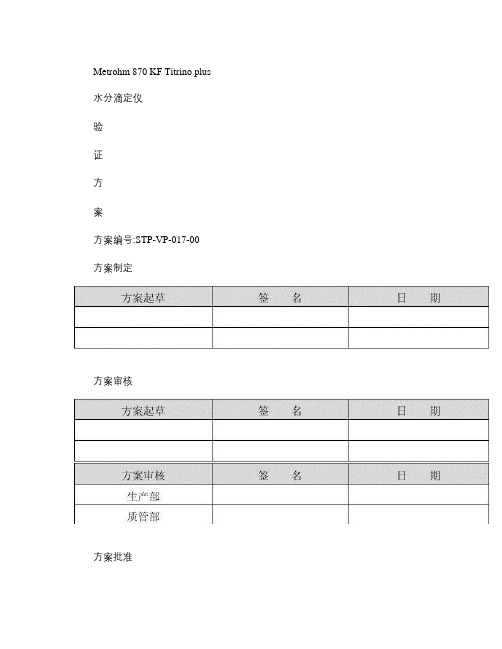
Metrohm 870 KF Titrino plus 水分滴定仪验证方案方案编号:STP-VP-017-00 方案制定方案审核方案批准验证小组人员名单目录1 水分滴定仪概述2 验证目的3 验证范围4 验证参考文件5 计划及进度6 设计确认7 安装确认8 运行确认9 性能确认10 验证周期1 水分滴定仪概述Metro 870 KF Titrino plus水分滴定仪是常茂生物化学工程股份有限公司按照卡尔-费休(Karl Fisher方法进行容量水分滴定的仪器。
2 验证目的确认Metro 870 KF Titrino plus水分滴定仪符合GMP标准及设计要求,所制定的标准文件符合GMP要求,确保水分滴定的准确性。
3 验证范围本验证方案适用于常茂生物化学工程股份有限公司的Metro 870 KF Titrino plus 水分滴定仪,该设备安装于质检科仪器室。
验证内容包括对Metro 870 KF Titrino plus水分滴定仪进行设计确认、安装确认、运行确认、性能确认。
4 验证参考文件本方案以国家药品监督管理局颁布的《药品生产质量管理规范》、由国家食品药品监督管理局组织编写的《药品生产验证指南》、中国药典2010年版为依据,制定了Metro 870 KF Titrino plus水分滴定仪的验证方案。
5 计划及进度整个验证活动分四个阶段完成:设计确认:从_____年_ _月_ _日至_____年___月___日;安装确认:从_____年___月__ 日至_____年__ 月__ 日;运行确认:从_____年___月__ 日至_____年__ 月__ 日;性能确认:从_____年___月_ _日至_____年__ 月__ 日。
6 设计确认6.1 供应商的资格和服务6.1.1 设备供应商应有良好的生产运营情况,没有与国家法规或地方法规相违背的生产状况。
6.1.2 安装时能提供现场指导或培训的技术人员数量、资格,并且将来在日常使用中能提供维修。
瑞士万通 870 KF Titrino plus
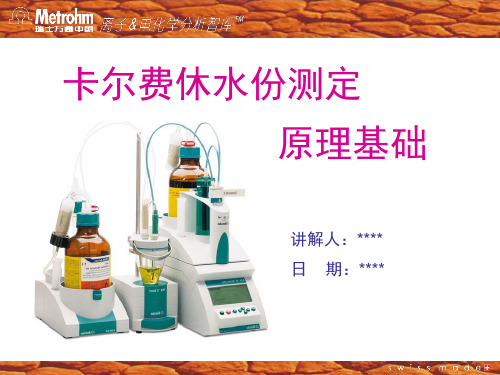
配置外部设备(Devices)
菜单(Menu) ▶ 系统(System) ▶ 设备(Devices)
PC/LIMS Printer Graphics width Keyboard layout Balance
COM2 | U 盘 Baudrate 波特率 Data bits 字长 打印机 Stop bits 结束位 图形宽度 Handshake 握手 键盘布局 Parity 奇偶校验位 天平
详细 控制参数(Control parameters)
菜单(Menu) ▶ 参数(Parameters) ▶ 控制参数(Control parameters)
停止标准 Stop criterion
Drift / µl/min
12 µl/min停止 6 µl/min停止 基线漂移 例如: 6 µl/min
详细 预滴定(Conditioning)
菜单(Menu) ▶ 参数(Parameters) ▶ 预滴定(Conditioning)
预滴定停止体积 Cond. Stop volume
在预滴定过程中最大允许配液的体积。若配液 的体积已达到该值,则停止预滴定。若通过重新按 下[开始](Start)的方式继续预滴定,则已经加入 的滴定液体积将被忽略不计,且配液重新由零开始。 应该根据滴定杯的大小调整停止体积,以防止溢出。
终点指示
标准品
Sigma 34828 HYDRANAL® - Water Standard 1.00 (0.1 H2O %)
ampoules, CofA in each box
34847 HYDRANAL® - Water Standard 0.10 (0.01 H2O %) ampoules, CofA in each box 34748 HYDRANAL® - Water Standard KF-Oven CofA in each box
